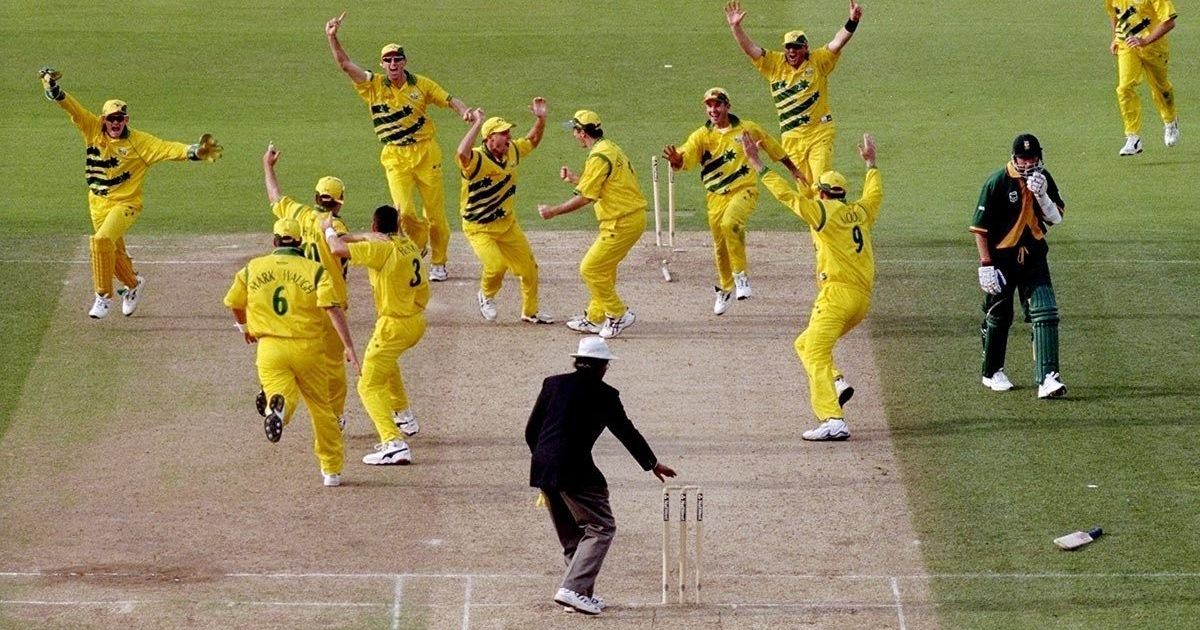5 closest finishes in the history of the World Cup

The World Cup is the absolute pinnacle in the game of cricket. The teams participating are all fired up and the players try to showcase the best of their abilities in chase of their ultimate dream. With the stakes so high, no wonder we see a plethora of tight matches during the World Cup. Many of these matches go right down to the wire to the final over and in some instances, the result is only decided on the final delivery of the match.
Here we take a look at 5 of the closest finishes in the long and glorious history of this tournament:
New Zealand vs South Africa, 2015 World Cup
A high-profile semi-final played in front of a charged up crowd in Auckland, both the sides were aiming to reach their first World Cup final. For most of the contest, South Africa seemed to be in charge, when the unlikeliest of heroes, Grant Elliot stepped up. Chasing 298 in 43 overs in a rain-curtailed tie, New Zealand were at one point struggling at 149-4 after 22 overs. Elliot played the knock of his life though, scoring 84 off only 73 deliveries. He was ably-supported Corey Anderson who scored 58 off 57 deliveries. The Kiwis required 5 runs off 2 balls when Elliot tonked the legendary Dale Steyn to create history.
Sri Lanka vs England, 2007 World Cup
Batting first, Sri Lanka posted a competitive score of 235 in 50 overs in the Super 8 match played in North Sound. Upul Tharanga was Sri Lanka’s most impressive performer with the bat, scoring a gritty 62. On a pitch which was not the most conducive for stroke-makers, the English batters struggled against the impressive Sri Lankan attack. Ravi Bopara and Paul Nixon kept England in the match, which was a must-win for them. England required two runs off the final delivery of the match, but Dilhara Fernando delivered the knock-out blow, dismissing Ravi Bopara in the last ball of the match.
India vs Australia, 1987 World Cup
In India’s first match of the 1987 World Cup, they were pipped in a high-profile encounter against Australia in Chennai. It was a memorable match as Australia batting first, put up a big score of 270/6 on the board courtesy of a brilliant 110 by Geoff Marsh. India were kept alive in the contest courtesy of brilliant knocks by K Srikanth and Navjot Singh Sidhu. Heading into the final over of the match, India required 2 runs off 2 deliveries, when Steve Waugh bowled Maninder Singh to hand the Aussies a memorable win.
India vs England, 2011 World Cup
Batting first in Bangalore, India got off to a brilliant start, courtesy of a brilliant knock from the Master Blaster himself, Sachin Tendulkar. Sachin’s knock of 120 helped India to a score of 338, which seemed like an almost impossible target to chase down. England though did not lose belief with captain Andrew Strauss leading from the front with one of the all-time great World Cup knocks of 158. He was well-supported by another senior member of the squad, Ian Bell, who scored 69 off 71 deliveries. Requiring 14 runs in the final over, England almost pulled off a famous win against the bowling of Munaf Patel. 2 runs were required off the final delivery, but Graeme Swann could only score a single, with the match ending in a tie.
Australia vs South Africa, 1999 World Cup
Unarguably, one of the most famous encounters in the history of the tournament. The match which earned South Africa great infamy along with the life-long tag of being the ‘chokers’. The Africans were regarded as one of the favourites to win the 1999 World Cup, having perhaps the strongest unit in the tournament. In the semi-finals, they faced off against Australia and were set a target of 214 runs, a reasonably comfortable one considering the batting lineup which they had. In the final over of the contest, South Africa had lost 9 wickets and required 9 runs to win with Damien Fleming being the bowler. The plus point for South Africa though was that they had the undisputed star of the tournament, Lance Klusener on strike. He relieved all the South African pressure in the first two deliveries of the over itself, by hitting them both for a boundary, thus tying the score. The third ball of the over was a dot. The fourth delivery and the action which preceded it then became immortal in the folklore of cricket. Klusener hit the ball towards the mid-off region and ran for the single. His partner at the non-striker’s end, Alan Donald, though was caught watching the ball and by the time he ran, it was too late and he was run-out. The match ended in a tie and Australia qualified for the final on the virtue of finishing higher in the super-sixes.
